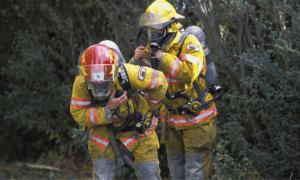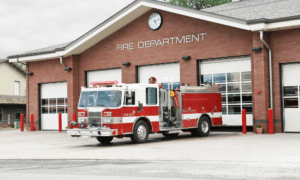June is National Safety Month, and while it usually focuses on physical safety, it’s also a perfect time to talk about financial safety. For firefighters and first responders, having your financial house in order is another form of protection. In this article, we’ll break down four practical steps you can take today to help keep your family financially secure when life throws a curveball.
Emergency Funds: Your Financial First Line of Defense
An emergency fund is a stash of readily accessible cash (that usually means in a savings account, not a CD or an asset you’d have to sell) that you only tap for true emergencies. We’re not talking “vacation in Cancún” emergencies; we mean the “transmission fell out of my truck” or “need a plane ticket for a family funeral” kind of emergencies. Experts recommend aiming for 3–6 months of living expenses in savings. For first responders, you might target the higher end – your job comes with risks, and an injury off-duty or major home repair could sideline you more easily than a desk worker.
Emergency Funds: Your First Line of Defense
Recent surveys show a lot of folks are unprepared: 37% of Americans would struggle to cover a $400 emergency expense out of pocket.[1] That means a good chunk of people have to rely on credit cards, loans, or sheer luck when an unexpected bill hits. You don’t want to be in that boat, paying 18% interest on a new set of tires. By setting aside cash, you’re essentially self-insuring against the small crises so you don’t have to whip out the credit card or borrow from your future self.
An emergency fund is great for short-term surprises, but what about bigger setbacks? Let’s talk about something more serious than a broken furnace – getting injured or ill and unable to work. For that, you need the next layer of protection: disability insurance.
Disability Insurance: Protecting Your Paycheck When You’re Sidelined
Disability insurance comes in a few flavors (short-term, long-term, employer-provided, private policies), but the gist is the same: if an injury or illness prevents you from working, this insurance will pay you a portion of your salary (often 50-70%) for a certain period. Think of it as paycheck protection. If you have sick leave and workers’ comp, those might cover on-the-job injuries for a while. But what happens after those benefits run out, or if you get hurt off the job? That’s where long-term disability insurance kicks in, ensuring you can keep the roof over your head and the family fed during extended downtime.
As a firefighter, your risk of injury is higher than most. One study found that firefighters file compensable injury claims at over four times the rate of the average worker. And it’s not just physical injuries – the rise in PTSD and other job-related illnesses has led to more disability claims among first responders in recent years. (For instance, in Minnesota, 257 first responder PTSD disability claims were filed in 2022 alone, a stark reminder of the mental toll of the job.) [2]
Disability Insurance: Protecting Your Paycheck
Even outside of firefighting, statistically about 30% of 35-year-olds will experience a disability lasting at least 90 days before they hit 65.[3] To put it starkly, you’ve got roughly a one-in-three chance of being out of work for three months or more at some point.
Now, many fire departments offer some disability benefits, but it’s worth checking the fine print. Is it short-term (covering just a few months)? Is it only job-injury coverage (workers’ comp)? It might make sense to supplement with a private policy. Yes, it costs money (usually a modest percentage of your salary), but it buys peace of mind.
Umbrella Liability Coverage: Shielding You from Life’s Legal Storms
Umbrella liability coverage is basically high-limit liability insurance. Say your auto policy covers you up to $300,000 for an accident, or your homeowners policy covers $500,000 for someone getting hurt on your property. If you’re found liable in a serious accident (imagine a multi-car pileup on a slick highway, or someone suffers a permanent injury slipping on your porch), the claims could easily exceed those base policy limits. An umbrella policy kicks in after those limits are exhausted, providing additional coverage (often starting at $1 million) so you’re not paying out of pocket for a million-dollar judgment. In short, it protects your savings, your home, your future earnings – everything you’ve worked hard for – from being seized or drained by a lawsuit.

Umbrella Liability Coverage: Shielding You from Life's Legal Storms
We live in a litigious society. Americans file roughly 15 million civil lawsuits every year.[4] First responders aren’t immune – off-duty accidents, side hustles (maybe you have a small carpentry business on the side), or even just owning a home with a swimming pool can put you at risk of an expensive claim. And these claims are only getting larger as medical costs and legal awards rise. According to one insurance company, umbrella liability claims have doubled from 2010 to 2020, and payouts jumped 67% to an average of about $500,000 per claim.[5] So the risk of a financially catastrophic lawsuit, while still slim for the average person, is growing. For someone with assets to protect (house, retirement, etc.), it’s a no-brainer layer of protection.
We’ve covered three solid layers – cash for the small stuff, insurance for the big personal setbacks, and an umbrella for the really big external hits. Now our final layer takes us into the digital realm. It’s 2025, and some of the risks we face aren’t just on the fireground or the highway – they’re online and often invisible. Let’s talk about cyber fraud and protecting yourself from high-tech scams.
Cyber-Fraud Threats
Scammers are no longer just the sketchy guys phishing with obvious typo-filled emails from “Prince Nigerian.” They’ve upped their game with AI-driven tricks. Imagine getting a call that sounds exactly like your chief or your spouse, saying they need money urgently. It’s happening. Deepfake technology has made it possible to mimic voices and even video, and criminals are cashing in on confusion and trust. The statistics are alarming: deepfake identity attacks surged by 704% in 2023.[6] Meanwhile, voice phishing scams are on the rise – about 68 million Americans (26% of adults) lost money to voice phishing in 2023, a 23% jump from the year before.[7]
Let that sink in: more than one in four people got stung by a phone scam in a single year! These scams can be incredibly convincing, using bits of personal info scraped from social media or public sources, and now AI to sound more legit.

Tips to stay digitally safe:
-
🛡️Set up defenses:Enable two-factor authentication (2FA) on important accounts so even if someone knows your password, they can't get in without your phone or fingerprint. Consider using a password manager to keep your logins strong and unique (no, "Firefighter123" is not a good password – we're all guilty of some easy ones).
-
📊Monitor and alert:Take advantage of free credit report alerts. You can place a free fraud alert through any one of the major credit bureaus, which makes it harder for identity thieves to open new accounts in your name. The moment something odd happens, you'll know, and early detection can save you months of headache undoing damage.
-
🔍Be skeptical and verify:If you get a call or message that raises an eyebrow, even if it's from someone you know, or a company you do business with. Hang up and call back on a known number to confirm.
-
👨👩👧👦Educate your family:You might be savvy, but what about your kids or that one less-techy relative? Share what you know. For example, tell them about the AI voice scam trend: if they ever get a call from a relative in distress asking for money, verify through another channel.
Bringing It All Together
Emergencies will happen – both the literal and the financial kind. The difference between a close call and a catastrophe is often the preparation and protection we put in place beforehand. As you observe National Safety Month this June, take a little time to check your financial gear. Need to start that rainy-day fund? Do it. Haven’t reviewed your insurance in a while? Schedule a chat with us. Getting complacent about passwords? Change them and set up that two-factor authentication. These are the drills that make sure, when the time comes, you’re ready.
With that being said, stay prepared, stay protected, and have a safe National Safety Month!
Sources:
- https://www.federalreserve.gov/publications/2024-economic-well-being-of-us-households-in-2023-expenses.htm
- https://kstp.com/kstp-news/top-news/proposed-bill-would-require-first-responders-to-undergo-months-of-treatment-before-applying-for-disability
- https://doctordisability.com/disability-statistics
- https://www.hanover.com/resources/tips-individuals/prepare-now-learn-how/15-every-day-activities-suggest-you-need-umbrella
- https://squarestateinsurance.com/umbrella-insurance-rates-rising
- https://www.weforum.org/stories/2025/01/how-ai-driven-fraud-challenges-the-global-economy-and-ways-to-combat-it
- https://www.usi.com/executive-insights/executive-series-articles/featured/personal-risk/q4-2024/ai-impact-on-cybercrime-what-you-need-to-know-right-now



